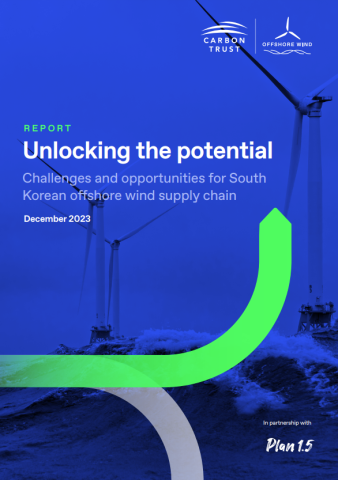Challenges and opportunities for South Korean offshore wind supply chain
This report lays out how to unlock South Korea’s offshore wind potential by assessing its supply chain readiness and providing tangible recommendations for its expansion.
Overview
South Korea’s Offshore Wind (OSW) industry is rapidly evolving to meet the nation’s target of at least 14.3 GW of offshore wind capacity by 2030. With a current pipeline of 21.3 GW of planned capacity, the country’s target is within reach, as long as supportive policy frameworks and adequate supply chain incentives are put in place.
The opportunity:
- Delivering 25 GW of offshore wind by 2035 would enable KRW 132 trillion investment and create up to 150,000 jobs.
- Policies supporting the local supply chain through skills development and worker transition programmes are urgently needed to capture this opportunity.
The supply chain:
- The local supply chain is still nascent with the largest amount of specialisation from local companies seen in the development and consenting stages, indicating the potential to grow across other parts of the supply chain such as installation, commissioning, turbine supply, balance of plant, and operations and maintenance.
- Clear market signals are needed to enable the required investment needed to expand the supply chain.
The ports:
- Existing port infrastructure is robust with many ports already capable of serving offshore wind operation and maintenance services. However, infrastructure upgrades and expansions will be needed to meet the demand for installation services in the upcoming years.
- Specific investment in deep water port upgrades will be necessary to support the pipeline of floating offshore wind projects.
The challenge:
- Slow permitting, policy uncertainty, and regional competition may lead to deployment delays and subsequent lost of economic opportunities.
한국 해상풍력(OSW) 산업은 2030년까지 해상풍력 발전 용량을 최소 14.3GW 확보하겠다는 국가 목표를 달성하기 위해 빠르게 발전하고 있습니다. 현재 21.3GW 계획 용량을 갖춘 파이프라인을 통해 지원 정책 프레임워크와 적절한 공급망 인센티브가 마련된다면 국가 목표를 달성할 수 있습니다.
기회:
- 2035년까지 해상풍력 25GW를 공급하면 132조 원의 투자와 일자리 최대 15만 개를 창출할 수 있습니다.
- 이 기회를 잡기 위해서는 기술 개발과 근로자 전환 프로그램들을 통해 현지 공급망을 지원하는 정책이 시급하게 필요합니다.
공급망:
- 한국 해상풍력 공급망은 아직 초기 단계로, 개발 및 동의 단계에 현지 기업이 가장 많이 나타나고 있어 설치, 시운전, 터빈 공급, 발전소 균형, 운영 및 유지보수 등 공급망의 다른 부분에서도 성장할 가능성이 있습니다.
- 공급망 확장에 필요한 투자를 활성화하기 위해서는 명확한 시장 신호가 필요합니다.
항만:
- 이미 해상풍력의 운영 및 유지보수 서비스를 제공할 수 있는 많은 항구와 함께 항만 인프라가 견고하게 구축돼 있습니다. 그러나 향후 몇 년간 설치 서비스 수요를 충족하기 위해서는 인프라 업그레이드와 확장이 필요합니다.
- 부유식 해상풍력 프로젝트의 파이프라인을 지원하려면 심해 항만 업그레이드에 대한 세부적인 투자가 필요합니다.
도전 과제:


